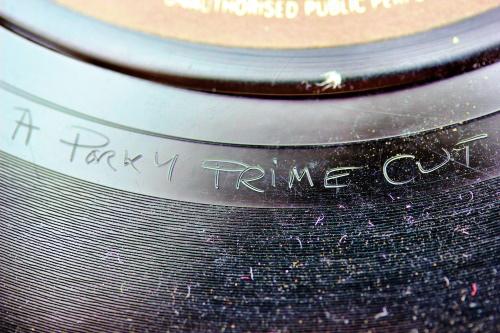Porky's Prime Cuts

Every LP begins life in a mastering studio. A mastering engineer must transfer the audio signal from the magnetic fluctuations on the master tape to a undulating groove of the master disc. Creating that groove is no easy task and much skill goes into the work. In my mind, a mastering engineer is the very definition of an artisan. Which brings us to George Peckham.
You might not know his name, but you've almost certainly heard his work. George Peckham was a mastering engineer extraordinaire. After a youthful stint as a musician, Mr. Peckham's mastering career started in 1968 when he was hired as trainee mastering engineer at Apple Studios in London. He was was soon promoted to chief engineer, then subsequently started his own mastering studio called The Master Room.
Over his long career, Mr. Peckham mastered thousands of LPs, including some of the greatest albums ever produced from groups such as The Beatles (and solo albums), The Who, Jethro Tull, King Crimson, Deep Purple, Elvis Costello, Yes, AC/DC, Peter Frampton, Emerson, Lake & Palmer, Genesis, Led Zeppelin, and even Monty Python. Regarding the latter, remember their “three-sided” album with two concentric grooves on side two? Yep, that was Mr. Peckham. More important, he was renown for the high quality of his work, cutting the grooves hot and filled with fidelity. Mr. Peckham is now retired, but his work lives on. His quirky sense of humor lives on too.
Recently, we looked at a curious LP that contained a bit of BASIC computer code. Almost no LPs have anything like this. That LP also had a matrix code inscribed in the run-out groove area, something that every LP has. The run-out groove became the blank scrolls for inscribing Mr. Peckham's gospel.
While still at Apple, he started adding notes to the run-out grooves of albums he had mastered. You might find a humorous or cryptic message, often referencing the artist or the record's lyrics. Sometimes there is a small drawing or a cartoon. The messages are often signed “Porky,” or “A Porky Prime Cut.” Other attributions include “Delta Pork,” “Pecko's Delta,” “Porky Pecko,” “Pecko Duck,” and many, many other weird iterations.
You can watch an interview of Mr. Peckham here. You can get a good sense of the man and more important, you can plainly see his enthusiasm for his work, his passion for his art. When you are immensely proud of your work, and profoundly pleased that so many people will find joy in it, signing your name is an obvious step. It's not uncommon for software engineers to leave a name or some personal note buried deep in their source code and yes, some CDs have a message with their matrix numbers, but that's rare. Mr. Peckham truly set the bar for personalized audio media. And in that respect, analog audio set the bar too, a bar that will never be superseded by cold and sterile digital audio.
Check your analog record collection, particularly your U.K. pressings. You too might have one of Porky's Prime Cuts.





























































